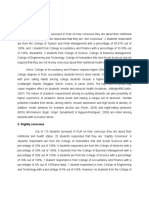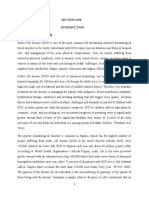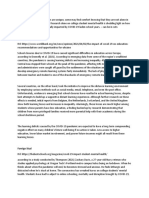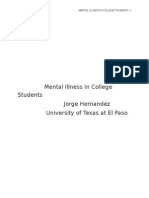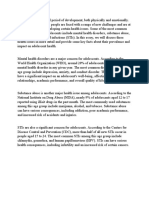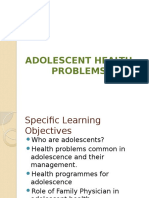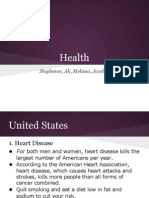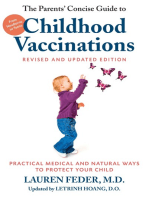8 Most Common College Diseases
8 Most Common College Diseases
Uploaded by
liezl_alvarez_1Copyright:
Available Formats
8 Most Common College Diseases
8 Most Common College Diseases
Uploaded by
liezl_alvarez_1Original Description:
Copyright
Available Formats
Share this document
Did you find this document useful?
Is this content inappropriate?
Copyright:
Available Formats
8 Most Common College Diseases
8 Most Common College Diseases
Uploaded by
liezl_alvarez_1Copyright:
Available Formats
8 Most Common College Diseases
College students are young, lively and generally healthy individuals, but just like any population, they are prone tocertain health problems. Not only do college students have some of the worst eating, exercising and sleeping habits,they also have to deal with stress from school, relationships and job hunting that takes a major toll on their health.Here are the 8 most common college diseases: 1.
Depression
: Depression is a growing issue that even college campuses are dealing with more and more. An alarming 44 percent of college students reported feeling symptoms of depression during college andmany do not seek treatment for their mental illness. Depression can be brought on by a number of factors,including anxiety from school or work, the loss of a loved one, a troubled relationship and early childhoodtrauma. College students have a high risk of being depressed because their hormones are often out of whack and imbalanced at this age, and they face a great deal of pressures and obstacles while in schooland away from their parents.2.
Meningococcal Meningitis
: Meningococcal meningitis is a rare but often deadly bacterial infection that isspread through air droplets and direct contact with infected persons. When the disease attacks, it will shutdown major organs and prevent blood flow to the limbs, often causing tissue to die and extremities to beamputated. From a national perspective, meningococcal meningitis is a rare disease that strikes fewer than 3,000 people every year. However, it tends to thrive on college students living in the dorms becauseof the close-quartered arrangements and their often weak immune systems.3.
Alcohol and Drug Addiction
: Alcohol and drug abuse has, and continues to be, a health problem amongcollege students. College students have higher rates of alcohol and drug addiction than the rest of thepublic, with nearly 2.7 million full-time college students abusing drugs and alcohol at least once a month. As students relish in their newfound freedom, they are more likely to try drugs and alcohol with friends for the first time. Although alcohol is still the preferred drug of choice by most college students, there has alsobeen an increase in marijuana and prescription drug abuse.4.
Sexually Transmitted Diseases
: With the increased amount of sexual activity and unprotected sexhappening in todays colleges, its no wonder why sexually transmitted diseases are rampant amongcollege students. An estimated 20 to 25 percent of college students have been infected or are carriers of STDs. Sexually active young adults have high rates of STDs because they do not use adequate protectionand often do not seek medical attention. Chlamydia, gonorrhea, herpes and HPV (Human Papillomavirus)are some of the most common STDs among college students.5.
Eating Disorders
: Eating disorders continue to be a major concern among college students today. Inaddition to the classic eating disorders like anorexia nervosa and bulimia nervosa, there are a number of other eating disorders not otherwise specified (EDNOS) that have become more rampant in college, suchas caloric restriction, drastic weight loss, excessive exercise, binging and purging. Disordered eating iscommonplace in college, when students are eating on their own and trying to avoid gaining the "freshman15."6.
Obesity
: Eating disorders continue to garner attention in college, but many students are troubled by theother end of the spectrum obesity. Today, more than 30 percent of college students are consideredobese or overweight by the American College Health Associations standards. A combination of unhealthydiets, limited physical activity and poor lifestyle choices has caused many college students to becomeobese or overweight.7.
Attention Deficit Hyperactivity Disorder (ADHD)
: We hear a great deal about the amount of studentsabusing Adderall and other psychostimulant medications in non-medical ways, but there is a growingnumber of college students being tested and diagnosed with ADHD, as well. The growing number of diagnoses can be attributed to several reasons, including the pressures of college studies, poor academic
You might also like
- 8 Most Common College DiseasesDocument13 pages8 Most Common College DiseasesgizleNo ratings yet
- Most Common Health IssuesDocument3 pagesMost Common Health Issuesuymaxx3No ratings yet
- Western Mindanao State University College of Nursing Zamboanga CityDocument16 pagesWestern Mindanao State University College of Nursing Zamboanga CityRoshin TejeroNo ratings yet
- Policy Document - Mental Health and Wellbeing 1Document11 pagesPolicy Document - Mental Health and Wellbeing 1api-248304871No ratings yet
- Facts About Eating Disorders: What The Research ShowsDocument3 pagesFacts About Eating Disorders: What The Research ShowsLauro Espiritu Jr.No ratings yet
- DiabetesDocument2 pagesDiabetesRash MI ER LagataNo ratings yet
- Wa0001.Document5 pagesWa0001.Santhini PrideepNo ratings yet
- Learners With Chronic Illness 1Document18 pagesLearners With Chronic Illness 1Charyl Mae AlipioNo ratings yet
- Diseases and Illness: English For NursingDocument4 pagesDiseases and Illness: English For Nursingvirasul husnaNo ratings yet
- G 10 Top 10 Most Common Health IssuesDocument3 pagesG 10 Top 10 Most Common Health IssuesJerald CañeteNo ratings yet
- Community Health Nursing NCM 104 2nd WeekDocument10 pagesCommunity Health Nursing NCM 104 2nd WeekGlyza EbradaNo ratings yet
- Final Research Paper in Ethics.Document11 pagesFinal Research Paper in Ethics.Myhlish FloresNo ratings yet
- Vaccine-Preventable Diseases Have Not Gone AwayDocument3 pagesVaccine-Preventable Diseases Have Not Gone AwayDaphne Ho F2D07No ratings yet
- Project ProposalDocument15 pagesProject ProposalAkinpelu 'Daewoo' Adewunmi50% (2)
- 10 Reasons To Get VaccinatedDocument1 page10 Reasons To Get VaccinatedLiz GamaNo ratings yet
- CHN 1 Topic 1. A Handout in Overview of Public Health Nursing in The Phils.Document11 pagesCHN 1 Topic 1. A Handout in Overview of Public Health Nursing in The Phils.DANIAH ASARI. SAWADJAANNo ratings yet
- NSTP 21Document4 pagesNSTP 21Bruce WayneNo ratings yet
- Meningococcal Disease: What College Communities Need To KnowDocument2 pagesMeningococcal Disease: What College Communities Need To KnowSinclair Broadcast Group - EugeneNo ratings yet
- Kiran PresentationDocument4 pagesKiran PresentationZaim verseNo ratings yet
- QuestionsDocument5 pagesQuestionsMapzy RiveraNo ratings yet
- Eating Disorders in AdolescenceDocument14 pagesEating Disorders in Adolescenceyashikag054No ratings yet
- Section One 1.1 Background To The StudyDocument35 pagesSection One 1.1 Background To The StudyComfort AlfredNo ratings yet
- Foreign RRL and SDocument4 pagesForeign RRL and SAlthea SaguinsinNo ratings yet
- Assignment 3.4 - Adeza GuntiaDocument3 pagesAssignment 3.4 - Adeza GuntiaAdeza GuntiaNo ratings yet
- Causes and Symptoms of Bipolar Disorder in College Students - Yinle OuyangDocument8 pagesCauses and Symptoms of Bipolar Disorder in College Students - Yinle OuyangLucian BlanksNo ratings yet
- Socanth ReportDocument28 pagesSocanth ReportGrace Solis SolanaNo ratings yet
- Study Guide HESI CommunityDocument29 pagesStudy Guide HESI CommunityBeth Ann100% (1)
- Poisoning Continue 6Document22 pagesPoisoning Continue 6louie john abilaNo ratings yet
- Importance of VaccinesDocument1 pageImportance of VaccinesKiana Vren B. JERMIANo ratings yet
- Prevalence and Risk Factors For Obesity and Overweight Among Elementarystudents at West Visayas State University - Integrated Laboratory School in 2013Document53 pagesPrevalence and Risk Factors For Obesity and Overweight Among Elementarystudents at West Visayas State University - Integrated Laboratory School in 2013Bryan AtasNo ratings yet
- Problems Faced by Students in UniversityDocument17 pagesProblems Faced by Students in UniversityMaham ButtNo ratings yet
- OCD and Related DisordersDocument6 pagesOCD and Related DisordersArooshma Ayub 17-111No ratings yet
- Chronic Stress and Suicidal Thinking Among Medical Students: Environmental Research and Public HealthDocument16 pagesChronic Stress and Suicidal Thinking Among Medical Students: Environmental Research and Public Healthmuhammad_hanis97No ratings yet
- 2023-24 Personal Fitness FINAL #2Document3 pages2023-24 Personal Fitness FINAL #2abdulrahmanhashi345No ratings yet
- Mental Illnes in College Students 2 WordDocument17 pagesMental Illnes in College Students 2 Wordapi-285846948No ratings yet
- Food Nutrition AssignmentDocument8 pagesFood Nutrition AssignmentKumari KrishnaNo ratings yet
- ResearchDocument6 pagesResearchDunhill GuanteroNo ratings yet
- Edu Assignment Group WorkDocument5 pagesEdu Assignment Group Workkelvinnjoro2022No ratings yet
- College StudentsDocument9 pagesCollege StudentsomarfilesyarmoukNo ratings yet
- J Cger 2015 04 009Document9 pagesJ Cger 2015 04 009hilman lesmanaNo ratings yet
- Final Paper SavageDocument17 pagesFinal Paper Savageapi-454361823No ratings yet
- Body of The ScriptDocument7 pagesBody of The ScriptKahlel IyoyNo ratings yet
- Adolescent HealthDocument47 pagesAdolescent HealthsushmaNo ratings yet
- Health DED 318Document14 pagesHealth DED 318Melissa SchartzNo ratings yet
- Concept Paper #2 (Quantitative Study)Document7 pagesConcept Paper #2 (Quantitative Study)erys.2211No ratings yet
- Biology ProjectDocument6 pagesBiology Projectdhriti1996singh100% (1)
- Mental Health of Students During PandemicDocument2 pagesMental Health of Students During PandemicDefinitely Not A RapistNo ratings yet
- Expanded Coverage of LiteracyDocument10 pagesExpanded Coverage of Literacycrista lauronNo ratings yet
- Psychological Effects of ObesityDocument7 pagesPsychological Effects of Obesityاحمد زينل محمدNo ratings yet
- College Students and Eating DisordersDocument3 pagesCollege Students and Eating DisordersXimena FloresNo ratings yet
- ManagementDocument7 pagesManagementfalguni dasNo ratings yet
- Bullying ArticleDocument6 pagesBullying Articlebarn5094100% (1)
- 11.03.2015 Part OneeerDocument4 pages11.03.2015 Part OneeerMonicaKozmerNo ratings yet
- Immunity & MalnutritionDocument2 pagesImmunity & MalnutritionMadhu BalaNo ratings yet
- Hiv Related Thesis TopicsDocument4 pagesHiv Related Thesis TopicsHelpWritingPapersSalem100% (2)
- Life StyleDocument3 pagesLife StylefamousamitNo ratings yet
- The Covid 19 Pandemic Has Presented Many Challenges To StudentsDocument2 pagesThe Covid 19 Pandemic Has Presented Many Challenges To StudentsLeah PascualNo ratings yet
- The Parents' Concise Guide to Childhood Vaccinations, Second Edition: From Newborns to Teens, Practical Medical and Natural Ways to Protect Your ChildFrom EverandThe Parents' Concise Guide to Childhood Vaccinations, Second Edition: From Newborns to Teens, Practical Medical and Natural Ways to Protect Your ChildNo ratings yet
- Brain Drain: How Highly Processed Food Depletes Your Brain of Neurotransmitters, the Key Chemicals It Needs to Properly FunctionFrom EverandBrain Drain: How Highly Processed Food Depletes Your Brain of Neurotransmitters, the Key Chemicals It Needs to Properly FunctionNo ratings yet
- Vaccines: Does herd immunity justify permanent impairment for a few?From EverandVaccines: Does herd immunity justify permanent impairment for a few?No ratings yet
- Nephrotic Syndrome: Practice GapDocument12 pagesNephrotic Syndrome: Practice GapMuhammad Isnaini ZuhriNo ratings yet
- All QuestionsDocument22 pagesAll Questionsmuran100% (1)
- NCP 1 Impaired Physical MobilityDocument3 pagesNCP 1 Impaired Physical Mobilityaaron tabernaNo ratings yet
- Trauma and Stressor Related DisordersDocument5 pagesTrauma and Stressor Related DisordersVillarino, Ian C.No ratings yet
- Drug-Study-Metformin 1Document2 pagesDrug-Study-Metformin 1Caroline Cha100% (1)
- Cam4 9 8333Document12 pagesCam4 9 8333Mithua ghoshNo ratings yet
- Living With Cancer-Related Fatigue Developling An Effective Management ProgrammeDocument7 pagesLiving With Cancer-Related Fatigue Developling An Effective Management Programmestorm.ghirlandoNo ratings yet
- Definition of The Case + Hyperthermia NCPDocument2 pagesDefinition of The Case + Hyperthermia NCPCindy MariscotesNo ratings yet
- Eyebrow and Eyelash Alopecia A Clinical ReviewDocument13 pagesEyebrow and Eyelash Alopecia A Clinical ReviewAndreiaEscudeiroNo ratings yet
- Nontoxic GoiterDocument4 pagesNontoxic GoiterpauchanmnlNo ratings yet
- Obesitas Pada Dewasa & Metabolisme LipidDocument62 pagesObesitas Pada Dewasa & Metabolisme Lipidilhamaminsyaputra100% (1)
- Prostat Tumor MarkerDocument20 pagesProstat Tumor MarkerChristian SihiteNo ratings yet
- 10 Hip Replacement SurgeryDocument13 pages10 Hip Replacement SurgeryDIA PHONG THANGNo ratings yet
- ERAS - ProtocolDocument5 pagesERAS - ProtocolShakya WeeraratneNo ratings yet
- The Nursing ProcessDocument1 pageThe Nursing Processryan catbaganNo ratings yet
- DRAINS.-WPS OfficeDocument14 pagesDRAINS.-WPS OfficeIsaac ayobamiNo ratings yet
- Prefix, Root, Suffix 1 AlphabeticalDocument23 pagesPrefix, Root, Suffix 1 AlphabeticalKai MeNo ratings yet
- PMLS ReviewerDocument6 pagesPMLS ReviewerGNo ratings yet
- STD Lesson 1Document8 pagesSTD Lesson 1api-277611497No ratings yet
- CAP - Molecular Pathology Resource GuideDocument288 pagesCAP - Molecular Pathology Resource Guidebluedisney85No ratings yet
- PLEURA Efusion KuliahLDocument46 pagesPLEURA Efusion KuliahLLuna LitamiNo ratings yet
- Kawasaki DiseaseDocument11 pagesKawasaki Diseaselittletaylor115No ratings yet
- Gastric Outlet ObstructionDocument25 pagesGastric Outlet ObstructionDr Shahzad Alam ShahNo ratings yet
- Microsoft Word - StressDocument2 pagesMicrosoft Word - StressAdriana TomaNo ratings yet
- Libro de Virología Dr. Juan Ernesto LudertDocument469 pagesLibro de Virología Dr. Juan Ernesto Luderta348851No ratings yet
- CefuroximeDocument2 pagesCefuroximeAngel CatalanNo ratings yet
- Factsheet - Ectopic Heartbeats (160201)Document1 pageFactsheet - Ectopic Heartbeats (160201)RodiAdiNo ratings yet
- Unit 6 A. Listening AnswerDocument4 pagesUnit 6 A. Listening AnswerLisna WatieNo ratings yet
- Renal TransplantDocument29 pagesRenal TransplantSujith Kuttan100% (2)
- Crypto Cocco SisDocument18 pagesCrypto Cocco SisSrinivas PingaliNo ratings yet



















